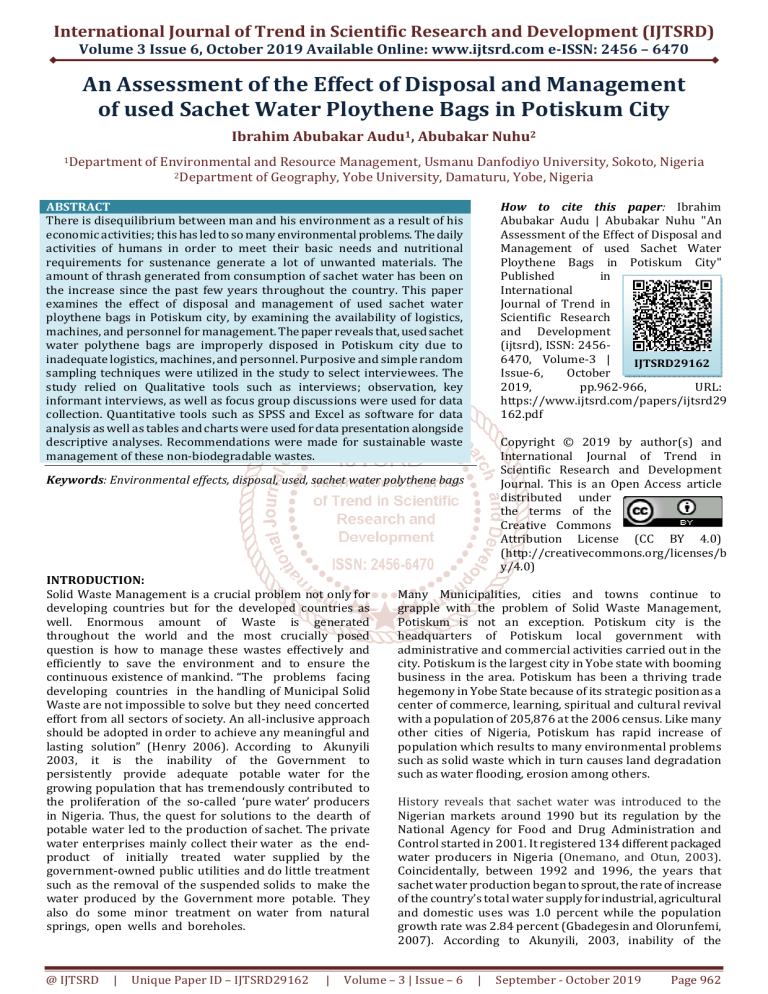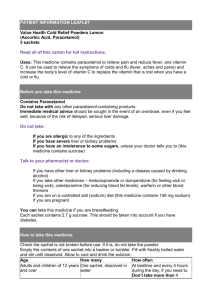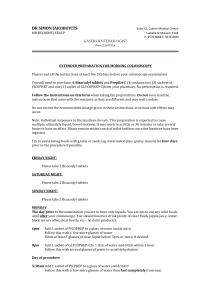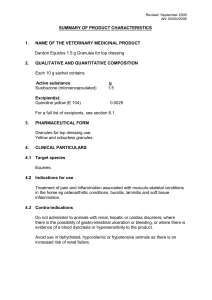
International Journal of Trend in Scientific Research and Development (IJTSRD)
Volume 3 Issue 6, October 2019 Available Online: www.ijtsrd.com e-ISSN: 2456 – 6470
An Assessment of the Effect of Disposal and Management
of used Sachet Water Ploythene Bags in Potiskum City
Ibrahim Abubakar Audu1, Abubakar Nuhu2
1Department
of Environmental and Resource Management, Usmanu Danfodiyo University, Sokoto, Nigeria
2Department of Geography, Yobe University, Damaturu, Yobe, Nigeria
How to cite this paper: Ibrahim
Abubakar Audu | Abubakar Nuhu "An
Assessment of the Effect of Disposal and
Management of used Sachet Water
Ploythene Bags in Potiskum City"
Published
in
International
Journal of Trend in
Scientific Research
and Development
(ijtsrd), ISSN: 24566470, Volume-3 |
IJTSRD29162
Issue-6,
October
2019,
pp.962-966,
URL:
https://www.ijtsrd.com/papers/ijtsrd29
162.pdf
ABSTRACT
There is disequilibrium between man and his environment as a result of his
economic activities; this has led to so many environmental problems. The daily
activities of humans in order to meet their basic needs and nutritional
requirements for sustenance generate a lot of unwanted materials. The
amount of thrash generated from consumption of sachet water has been on
the increase since the past few years throughout the country. This paper
examines the effect of disposal and management of used sachet water
ploythene bags in Potiskum city, by examining the availability of logistics,
machines, and personnel for management. The paper reveals that, used sachet
water polythene bags are improperly disposed in Potiskum city due to
inadequate logistics, machines, and personnel. Purposive and simple random
sampling techniques were utilized in the study to select interviewees. The
study relied on Qualitative tools such as interviews; observation, key
informant interviews, as well as focus group discussions were used for data
collection. Quantitative tools such as SPSS and Excel as software for data
analysis as well as tables and charts were used for data presentation alongside
descriptive analyses. Recommendations were made for sustainable waste
management of these non-biodegradable wastes.
Copyright © 2019 by author(s) and
International Journal of Trend in
Scientific Research and Development
Journal. This is an Open Access article
distributed under
the terms of the
Creative Commons
Attribution License (CC BY 4.0)
(http://creativecommons.org/licenses/b
y/4.0)
Keywords: Environmental effects, disposal, used, sachet water polythene bags
INTRODUCTION:
Solid Waste Management is a crucial problem not only for
developing countries but for the developed countries as
well. Enormous amount of Waste is generated
throughout the world and the most crucially posed
question is how to manage these wastes effectively and
efficiently to save the environment and to ensure the
continuous existence of mankind. “The problems facing
developing countries in the handling of Municipal Solid
Waste are not impossible to solve but they need concerted
effort from all sectors of society. An all-inclusive approach
should be adopted in order to achieve any meaningful and
lasting solution” (Henry 2006). According to Akunyili
2003, it is the inability of the Government to
persistently provide adequate potable water for the
growing population that has tremendously contributed to
the proliferation of the so-called ‘pure water’ producers
in Nigeria. Thus, the quest for solutions to the dearth of
potable water led to the production of sachet. The private
water enterprises mainly collect their water as the endproduct of initially treated water supplied by the
government-owned public utilities and do little treatment
such as the removal of the suspended solids to make the
water produced by the Government more potable. They
also do some minor treatment on water from natural
springs, open wells and boreholes.
@ IJTSRD
|
Unique Paper ID – IJTSRD29162
|
Many Municipalities, cities and towns continue to
grapple with the problem of Solid Waste Management,
Potiskum is not an exception. Potiskum city is the
headquarters of Potiskum local government with
administrative and commercial activities carried out in the
city. Potiskum is the largest city in Yobe state with booming
business in the area. Potiskum has been a thriving trade
hegemony in Yobe State because of its strategic position as a
center of commerce, learning, spiritual and cultural revival
with a population of 205,876 at the 2006 census. Like many
other cities of Nigeria, Potiskum has rapid increase of
population which results to many environmental problems
such as solid waste which in turn causes land degradation
such as water flooding, erosion among others.
History reveals that sachet water was introduced to the
Nigerian markets around 1990 but its regulation by the
National Agency for Food and Drug Administration and
Control started in 2001. It registered 134 different packaged
water producers in Nigeria (Onemano, and Otun, 2003).
Coincidentally, between 1992 and 1996, the years that
sachet water production began to sprout, the rate of increase
of the country’s total water supply for industrial, agricultural
and domestic uses was 1.0 percent while the population
growth rate was 2.84 percent (Gbadegesin and Olorunfemi,
2007). According to Akunyili, 2003, inability of the
Volume – 3 | Issue – 6
|
September - October 2019
Page 962
International Journal of Trend in Scientific Research and Development (IJTSRD) @ www.ijtsrd.com eISSN: 2456-6470
Government to provide persistently adequate potable water
for the growing population tremendously contributed to the
proliferation of the so-called ‘pure water’ producers in
Nigeria. Thus, production of sachet water came up as a
solution to the dearth of potable water provision.
As the country population grew and industries increased, the
supply of water by the public utilities became inadequate in
quality and quantity. This led to the emergence, and
proliferation of more and more private water enterprises
that operated side by side with the government-owned
public water utilities. Almost every nook and cranny in
Potiskum is littered with sachet water polythene bags.
This is as a result of indiscriminate disposal of sachet
water bags onto the streets of virtually every corner in
Potiskum. The sachets are made of non-biodegradable
synthetic polyethylene (polythene), which does not decay,
decompose or corrode, and which when burnt, produces
oxides of carbon, nitrogen and sulphur. However, the water
sources and purification technologies are not up to the safe
standards. Sources of water are generally surface and
ground water. National agency for food, Drugs,
Administration and control (NAFDAC) approved tap water
(surface water), borehole (ground water) and spring water
as sources of raw water for packaged water production
(Abati, 2005).
The oxides of carbon, sulphur and nitrogen, methane,
particulate matter and others, produced from burning of
disposed water sachets causes various health problems
such as cancer, brain damage, dizziness, headache,
fatigue, respiratory problem, and eye irritation. Such
conditions, according to Adenuga 2006 can precipitate
epidemics and national heath crises. When the
environment is damaged, both consumers and non-
consumers of sachet water are affected since the
environment is exhaustively composed of the two
groups. Notwithstanding the above negative externalities of
sachet water production, due to the availability,
accessibility and issues of packaging, sachet water for
drinking is still prominent. This paper aims at filling the
research gap on sachet water polythene bag waste
management in Yobe state commercial center (Potiskum). It
also provides a baseline data for policy makers and
donors who are interested in the subject matter.
Methodology
Apart from the use of documented sources, the study
also generated firsthand information from the field.
Purposive and simple random sampling techniques were
utilized in the study to select 9 0 interviewees. The
study relied on qualitative and quantitative approaches,
taken in to consideration, sources of data, sampling
techniques, data collection techniques, as well as data
analysis and presentation techniques. The study area,
Potiskum was purposively chosen due to the fact that, it
is commercial center of Yobe state with ongoing
commercial activities, cognizance of the fact that there
is a link between waste generation and level of commercial
activities. Qualitative tools such as interviews, observation,
key informant interviews, as well as focus group
discussions were used for data collection. Quantitative
tools namely SPSS and Excel as software for data analysis
as well as tables and charts were used for data
presentation alongside descriptive analyses. The study
settled on a sample size of 80 based on the formular of Taro
1970. Ninety (90) questionnaires were administered, but
only eighty (80) copies were properly filled out, returned
and used for analysis.
Results
Equipment used in the management of sachet water plastic waste
Equipment used in the management of sachet water plastic waste in Potiskum city can be categorized into two. They
are machines and personnel.
Machines used in the management of sachet water plastic waste in Potiskum city
The table b e l o w shows t h e machines required/ available in Potiskum city for the management of sachet plastic waste as
at March, 2019.
Machines
Roll on/off truck
Compacters
Pick-up truck
Bulldozer
Number available
3
0
Number required
8
5
0
0
Source: Field survey 2019
15
5
The city can only boast of a Roll on/off truck. It is the only machine available in the city for the collection of sachet water
plastic waste and other solid waste. However, the absence of compacters, pickup trucks, and bulldozers in Potiskum city has
hampered the management of sachet water plastic waste and other solid waste. These inadequacies of the machines are as a
result of the fact that all the machines required are imported and hence expensive. Also the machines require specialized
skills for operation. Also, spare parts to maintain these machines are not readily available when the machines break
down.
Personnel for the management of sachet water plastic waste in Potiskum city
Figure 1: This figure shows a graph showing the number of personnel required/available in the management
of sachet water plastic waste in Potiskum city as at March 2019.
@ IJTSRD
|
Unique Paper ID – IJTSRD29162
|
Volume – 3 | Issue – 6
|
September - October 2019
Page 963
International Journal of Trend in Scientific Research and Development (IJTSRD) @ www.ijtsrd.com eISSN: 2456-6470
Source: Field survey 2019
Figure 1, Presents the number of personnel required and the one available in the management of sachet water plastic
waste in Potiskum city. The personnel are employed from within the community in order to ensure prompt service delivery.
Figure 1 as well as table 1 suggests that machines and personnel for the management of sachet water polythene bag waste are
inadequate leading to inappropriate management.
Factors contributing to inappropriate management of sachet water plastic in Potiskum city
Inappropriate management of sachet water plastic waste in Potiskum city can be attributed to a number of factors. The
analysis below provides a proof of some of the factors that cause the menace.
Inadequacy of equipment and personnel in the management of sachet water plastic waste in Potiskum city
Inadequate supply of equipment coupled with insufficient personnel curtails the ability of local government
and state government to effectively clear the heaps of sachet water plastic waste in the entire state governments, and
understaffed manpower for waste management in the study area.
Methods of disposal of sachet water plastic at household level
From figure 2 below, good percentages (68%) of respondents litter the streets with sachet water plastic waste on the
streets while only 7% rely on an environmentally friendly way of disposing the sachet water plastic waste (reuse for nursing
seedlings). More so only 11% of respondents are able to deposit their sachet water plastic wastes i n t h e w a s t e
b i n . It was explained that the dustbins are not available in the whole city to put the waste in. This has accounted for the
inappropriate management of sachet water thrash at the household level in Potiskum city thereby increasing the burden of
stretched community in order to ensure prompt service delivery.
Source: Field survey 2019
Causes of inappropriate management of sachet water plastic waste in Potiskum
Table 3 presents the views of waste management experts in Potiskum city with regards to factors contributing to
improper management of sachet water plastic waste. 37.5% of the poorly managed (littered) sachet water plastic waste
in Potiskum city is attributable to inadequacy of logistics and personnel in the city.
@ IJTSRD
|
Unique Paper ID – IJTSRD29162
|
Volume – 3 | Issue – 6
|
September - October 2019
Page 964
International Journal of Trend in Scientific Research and Development (IJTSRD) @ www.ijtsrd.com eISSN: 2456-6470
Table2: This table shows factors responsible for poor management of sachet water plastic waste in the
Potiskum city.
Causes of poor management sachet water plastic waste
Frequency Percentage (%)
Low patronage in community clean up exercises
20
25
Poor attitude of inhabitants towards management of sachet water plastic waste
25
31.25
Inadequate logistics /personnel
30
37.5
Others
5
6.25
Source: Field survey 2019
Consequences of inappropriate management of sachet water polythene waste
Inappropriate management of sachet water polythene waste poses a serious threat on the environment which in turn
affects humanity. This consequence ranges from health, economic, even on governance.
Health Risk
Improper management of sachet water plastic waste has been identified as one of the major contributory factors to mosquito
breeding which consequently contributes to the prevalence of malaria in the community. The littered plastic waste tends
to collect water from rains. The water collected provides a conducive breeding environment for mosquitoes and thereby
increasing the incidence of malaria in the community with its attendant consequences (Environmental Health
Unit 2012)
Disaster Risk
Littered sachet water plastic waste has been named by National Disaster Management Organization in the
municipality as a number one anthropogenic cause of flooding. Littered sachet water plastic waste finds their way into
the drainage systems in the community. With time the gutters gets choked. Consequently flooding occurs after heavy
downpours (National Disaster Management Organization, 2015)
Environmental decay and Investment Drive
Unsightly environment created by littering of sachet water plastic waste has also been identified as a major
disincentive to investment drive in the community. In other words an environment characterized by poor
environmental sanitation scares away investors (National Boards for Small scale Industries, 2013).
Figure 3: A diagram showing a chain of consequence’s that result from improper management of sachet water plastic
waste in Potiskum city.
The conceptual model in figure 3 depicts the comprehensive views of respondents and stakeholders in waste
management on the possible consequences of the improper management of sachet water plastic waste on the living
standard of individuals as well as on the environment. These consequences are triggered by littering and burning of
sachet water plastic waste. Once sachet water plastic waste is littered or burnt, a path of consequences unfolds to impact
negatively on the inhabitants, environment as well as the government. These consequences tend to lower the living
standards of the inhabitants.
@ IJTSRD
|
Unique Paper ID – IJTSRD29162
|
Volume – 3 | Issue – 6
|
September - October 2019
Page 965
International Journal of Trend in Scientific Research and Development (IJTSRD) @ www.ijtsrd.com eISSN: 2456-6470
Conclusion
The study has made efforts to identify the drivers of
improper management of sachet water plastic waste in
Potiskum city. It is clear from the study that, the
menace results from inappropriate methods of disposing
sachet water plastic waste by consumers. This coupled with
low capacity of the local government authority to
adequately scavenge sachet water plastic thrash from
the streets of Potiskum has resulted in the aggravation of
the menace. This situation provides a conducive ground for
mosquito breeding and consequently increases in the
risk of malaria prevalence in the community with its
attendant disaster and investment effects. In order that the
situation of improper management of sachet water plastic
waste is brought to the barest minimum, the study
has identified a number of recommendations which
when carefully implemented could best help curb the
menace in Potiskum city. However, given the economic,
political and socio cultural characteristics of the inhabitants
of Potiskum city some of the recommendations would not be
applicable. Some of these recommendations are as follows:
Reference
[1]. Abati, T. (2005): Water Sources and Treatments”, Food
Forum, Nigerian Institute of Food Science and
Technology, P.10
Polluter pays principle by imposition a well-defined plastic
pollution responsibility charges that equally target all plastic
producers and retailers whose products litter the streets, as
well as consumers of plastics. Potiskum local government
authority should introduce a Deposit Refund System as a
useful method in managing the sachet water plastic thrash
from the streets. In this system sachet water should be
offered for sale at two times higher than the current
price, when a consumer purchases at this new
price ,there exist the opportunity for him or her to be
paid back half the price if the thrash is returned to the
seller or any collection point. Interested stakeholders can
now buy the empty sachets for reuse or recycling. Reuse (for
nursing seedlings), Outright ban (Ceasing producers from
the use of non-biodegradable material to package water),
Increases the efficiency of institutions responsible for sachet
water plastic waste adequate supply of waste-bins at
vantage points to discourage littering, and Frequent
organization of community clean up exercises.
[7]. National Disaster Management Organization (2015):
Data on the Disaster Effects of Inappropriate
Management of Used Sachet Water Polythene Bags in
Nigeria.
@ IJTSRD
|
Unique Paper ID – IJTSRD29162
|
[2]. Adenuga S, John W. (2006): Technological Reference
Paper on Recycling Plastics. GNA(2005). AMA to
temporarily ban use of plastics.
[3]. Akunyili D.N. (2003): The Role of Pure Water and
Bottled Water Manufacturers in Nigeria, Paper
presented at the 29th Water, Engineering and
Development Centre International Conference, in
Abuja, Nigeria.
[4]. Environmental Health Unit (2012): Data on Diseases
and Consequences in the Yobe State.
[5]. Gbadegesin N. and Olorunfemi, F. (2007): Assessment of
Rural Water Supply Management in Selected Rural
Areas of Oyo State”, ATPS Working Paper Series No. 49.
[6]. Henry M. ( 2006.): Recycling Activities in Metro
Manila, London, Routldge
[8]. National Boards for Small scale Industries (2013): Data
on the Investment Effects of Poor Environmental
Sanitation.
[9]. Onemano J. I., and Otun, J. A. (2003): Problems on Water
Quality Standards and Monitoring in Nigeria, Paper
presented at the 29th Water, Engineering and
Development Centre International Conference, in
Abuja, Nigeria.
[10]. Taro Y. Statistics (1970): An Introductory Analysis.
2nded. New York: A. Harper international ed. jointly
publ. by Harper & Row and John Weather hill.
1970.
Volume – 3 | Issue – 6
|
September - October 2019
Page 966





